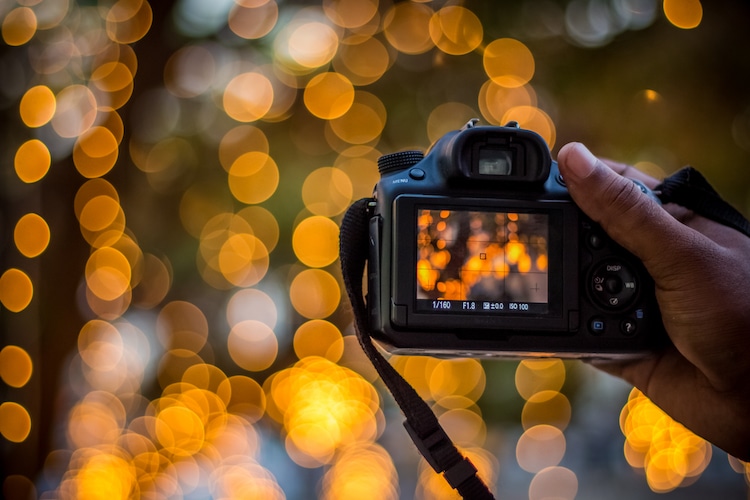
Photo: srinivasansri5560/Depositphotos
This post may contain affiliate links. If you make a purchase, My Modern Met may earn an affiliate commission. Please read our disclosure for more info.
Photography, like other forms of visual art, has a variety of effects that allow you to express your creativity. One of the most popular is called bokeh. This effect refers to the aesthetic quality of the out-of-focus areas of an image, most commonly in the form of circles that dot a composition.
One of the easiest ways to imagine bokeh is by seeing city lights from far away. In the distance, they look fuzzy, like baubles of brightness. But the elements in the foreground are sharp and in focus. This juxtaposition is an eye-pleasing one and makes a scene feel cozy.
Now that you have a brief introduction to the bokeh effect, learn about its different types and how to achieve it in your photography.
View this post on Instagram
What is the difference between blur and bokeh?
Bokeh is a type of blurriness, but not all blurriness is bokeh. The easy way to spot bokeh is the circles—sometimes called “circles of confusion”—that are seen in an out-of-focus background or foreground. The circles of light are from the highlights in the composition, such as the tail lights on a car.
Bokeh is an English term that’s been translated from the Japanese words “暈け” or “ボケ,” which refers to a specific type of out-of-focus blur. Bokeh refers to aesthetic quality, which is why using blur to describe the effect isn’t wholly accurate.
Background blur is a common type of blurring in photography. This occurs when there is a shallow depth of field, which is the sharpness of the image in front of or behind the main subject. Motion blur is also common, where the subject is moving too fast for the camera’s shutter speed.
If you don’t see any jewel-like dots in the composition, chances are that it doesn’t have the bokeh effect.
View this post on Instagram
Types of Bokeh
Bokeh varies in appearance that depends on different factors, such as equipment and the specific conditions of a scene. Here are the common types of bokeh you might see.
Creamy or Smooth Bokeh
When you think of bokeh, this is likely what comes to mind. Creamy bokeh refers to the quality of the circular elements. They are smooth, and the out-of-focus areas have no visible sharp edges or otherwise distracting elements.
Busy Bokeh
Not all bokeh is created the same. When the out-of-focus areas have distracting shapes or off-putting patterns, it can detract from the main subject.
Night Bokeh
This type of bokeh refers to a bokeh that’s captured at night or in low-light conditions. Because of the sharp contrast, the effect is more pronounced.
Double Bokeh
You’re seeing two in this bokeh. Double bokeh occurs when the circles of confusion show multiple instances of highlights. Typically, this happens when there are numerous light sources or reflective surfaces. The results create a visually complex bokeh effect.
Colored Bokeh
Colorful bokeh occurs when the out-of-focus areas take on the hues that are present in the scene. While this describes the color qualities of the dots, colorful bokeh can also be smooth, busy, or double.
View this post on Instagram
Tips for Creating the Bokeh Effect
Want to achieve the bokeh effect in your photographs? Here are some of the top tips for how to create bokeh.
- Use a lens with a wide maximum aperture (the opening in which light passes through). On a manual setting, you’ll want your camera to have a small f-number. This will help you achieve a shallow depth of field.
- Position your subject relatively close to the camera to create a noticeable distance between the subject and the background.
- Look for texture in your composition. You won’t get bokeh with a white wall. Look for textured surfaces that will have highlights and reflections in order to create a bokeh effect.
- Choose a lens that’s known for creating bokeh. Nikon’s NIKKOR Z 50mm f/1.2 S is considered a great lens up to the task.
- Experiment with different manual settings, including focal length and aperture, to try different depths of field and the background blur.
- Always notice what’s around you. How could these environmental elements contribute to bokeh? Use them to your advantage, or make a plan to obscure them.
View this post on Instagram
Bokeh Effect Tutorials on YouTube
YouTube tutorials are a great way to learn how to create bokeh. Check out these videos for tutorials and tips you can use to achieve this cozy effect.
Bokeh Basics: Take and Make Great Photography with Gavin Hoey
Top 7 Ways to Create Buttery Bokeh
How to Get Big Bokeh Balls in the Background
Bokeh Photography—The Easy Way
Related Articles:
Enchanting Bokeh Portraits of Snails Showcases Their Humble Beauty in a New Light
Dazzling Nighttime Cityscapes Are Reimagined as Beautiful Bokeh-Style Paintings
Emotive Oil Paintings of Nostalgic Beach Scenes in Beautiful Bokeh
